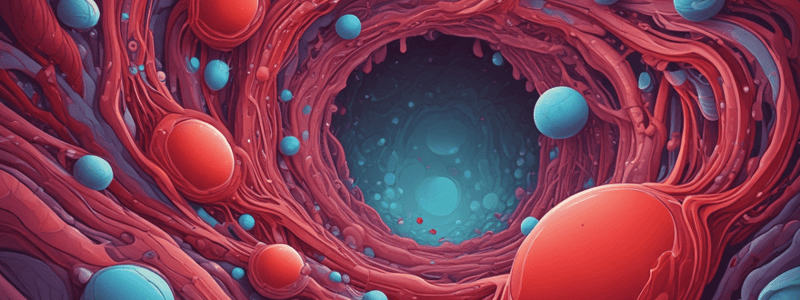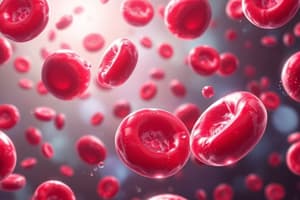Podcast
Questions and Answers
What is the meaning of 'bi' in the term 'biconcave'?
What is the meaning of 'bi' in the term 'biconcave'?
- Convex
- Curved
- Two (correct)
- Half
What is the advantage of erythrocytes being flexible?
What is the advantage of erythrocytes being flexible?
- Enhanced oxygen carrying capacity
- Improved production in the bone marrow
- Increased surface area for gas exchange
- Ability to pass through capillaries (correct)
What is the shape of an erythrocyte that increases its surface area for gas exchange?
What is the shape of an erythrocyte that increases its surface area for gas exchange?
- Biconcave (correct)
- Elliptical
- Cubical
- Spherical
Which group of animals has nucleated erythrocytes?
Which group of animals has nucleated erythrocytes?
What is the characteristic of erythrocytes that distinguishes them from other cells?
What is the characteristic of erythrocytes that distinguishes them from other cells?
Erythrocytes have a nucleus in all vertebrates.
Erythrocytes have a nucleus in all vertebrates.
The biconcave shape of erythrocytes reduces their surface area for gas exchange.
The biconcave shape of erythrocytes reduces their surface area for gas exchange.
Erythrocytes are rigid and inflexible.
Erythrocytes are rigid and inflexible.
The curvature of erythrocytes is outwards.
The curvature of erythrocytes is outwards.
The shape of erythrocytes has no effect on their ability to exchange gases.
The shape of erythrocytes has no effect on their ability to exchange gases.
Erythrocytes are ______ apart from those in birds, reptiles, amphibians, and fish.
Erythrocytes are ______ apart from those in birds, reptiles, amphibians, and fish.
The shape of erythrocytes is described as ______ concave.
The shape of erythrocytes is described as ______ concave.
Erythrocytes are ______ to pass through capillaries.
Erythrocytes are ______ to pass through capillaries.
The ______ shape of erythrocytes increases their surface area for gas exchange.
The ______ shape of erythrocytes increases their surface area for gas exchange.
The ______ of erythrocytes curves inwards.
The ______ of erythrocytes curves inwards.
Match the characteristics of erythrocytes with their corresponding advantages:
Match the characteristics of erythrocytes with their corresponding advantages:
Match the features of erythrocytes with their descriptive terms:
Match the features of erythrocytes with their descriptive terms:
Match the characteristics of erythrocytes with the exceptions:
Match the characteristics of erythrocytes with the exceptions:
Match the characteristics of erythrocytes with their functions:
Match the characteristics of erythrocytes with their functions:
Match the terms with their corresponding meanings in the context of erythrocytes:
Match the terms with their corresponding meanings in the context of erythrocytes:
Match the following characteristics of RBCs with their descriptions:
Match the following characteristics of RBCs with their descriptions:
Match the following characteristics of RBCs with their effects on RBCs' functionality:
Match the following characteristics of RBCs with their effects on RBCs' functionality:
Match the following characteristics of RBCs with their species-specific examples:
Match the following characteristics of RBCs with their species-specific examples:
Match the following RBC characteristics with their effects on RBC flexibility:
Match the following RBC characteristics with their effects on RBC flexibility:
Match the following characteristics of RBCs with their relevance to gas exchange:
Match the following characteristics of RBCs with their relevance to gas exchange:
What is the primary function of erythrocytes in the body?
What is the primary function of erythrocytes in the body?
Where are erythrocytes produced in the body?
Where are erythrocytes produced in the body?
What is the average lifespan of erythrocytes?
What is the average lifespan of erythrocytes?
What is the purpose of the hormone erythropoietin?
What is the purpose of the hormone erythropoietin?
Where do erythrocytes typically get broken down?
Where do erythrocytes typically get broken down?
Erythrocytes can leave the cardiovascular system without any damage to blood vessels.
Erythrocytes can leave the cardiovascular system without any damage to blood vessels.
The spleen is responsible for producing RBCs in the body.
The spleen is responsible for producing RBCs in the body.
Erythrocytes have a heterogeneous shape.
Erythrocytes have a heterogeneous shape.
Erythrocytes can live up to 200 days on average.
Erythrocytes can live up to 200 days on average.
Erythrocytes carry O2 to the tissues using a protein other than haemoglobin.
Erythrocytes carry O2 to the tissues using a protein other than haemoglobin.
Erythropoietin is a hormone produced by the ______
Erythropoietin is a hormone produced by the ______
The major sites for the breakdown of RBC are the spleen and ______
The major sites for the breakdown of RBC are the spleen and ______
The average lifespan of RBC is approximately ______ days
The average lifespan of RBC is approximately ______ days
RBC function to carry O2 to the tissues utilizing ______ for this
RBC function to carry O2 to the tissues utilizing ______ for this
RBC will never leave the cardiovascular system unless a blood vessel is ______
RBC will never leave the cardiovascular system unless a blood vessel is ______
Match the following organs with their roles in the lifecycle of RBCs:
Match the following organs with their roles in the lifecycle of RBCs:
Match the following characteristics of RBCs with their relevance to RBC shape:
Match the following characteristics of RBCs with their relevance to RBC shape:
Match the following with their functions in the body:
Match the following with their functions in the body:
Match the following with their effects on RBCs' movement:
Match the following with their effects on RBCs' movement:
Match the following with their locations in the body:
Match the following with their locations in the body:
What is the function of the iron atom in each molecule of haemoglobin?
What is the function of the iron atom in each molecule of haemoglobin?
Why does iron deficiency lead to feelings of tiredness?
Why does iron deficiency lead to feelings of tiredness?
What is the difference between oxyhaemoglobin and deoxyhaemoglobin?
What is the difference between oxyhaemoglobin and deoxyhaemoglobin?
What is the advantage of having haemoglobin in red blood cells?
What is the advantage of having haemoglobin in red blood cells?
How many molecules of oxygen can each molecule of haemoglobin bind?
How many molecules of oxygen can each molecule of haemoglobin bind?
What is the primary function of haemoglobin in erythrocytes?
What is the primary function of haemoglobin in erythrocytes?
How many oxygen molecules can each molecule of haemoglobin bind?
How many oxygen molecules can each molecule of haemoglobin bind?
What color does deoxygenated haemoglobin appear as?
What color does deoxygenated haemoglobin appear as?
Why do people feel tired when they are iron deficient?
Why do people feel tired when they are iron deficient?
What is the advantage of having haemoglobin in red blood cells for oxygen transportation?
What is the advantage of having haemoglobin in red blood cells for oxygen transportation?
Flashcards are hidden until you start studying



